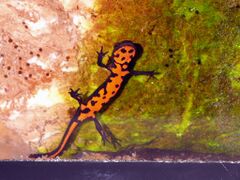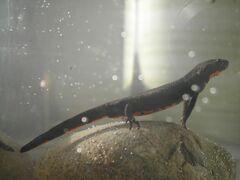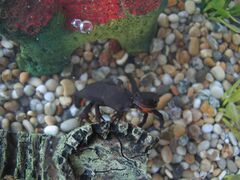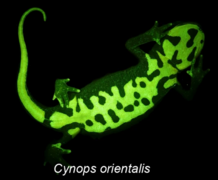Biology:Chinese fire belly newt
| Chinese fire belly newt | |
|---|---|

| |
| Scientific classification | |
| Domain: | Eukaryota |
| Kingdom: | Animalia |
| Phylum: | Chordata |
| Class: | Amphibia |
| Order: | Urodela |
| Family: | Salamandridae |
| Genus: | Cynops |
| Species: | C. orientalis
|
| Binomial name | |
| Cynops orientalis (David, 1873)
| |
| Synonyms | |
|
Hypselotriton orientalis (David, 1873) | |
The Chinese fire belly newt (Cynops orientalis) is a small (2.2–4.0 inches (5.6–10.2 cm)) black newt, with bright-orange aposematic coloration on their ventral sides. C. orientalis is commonly seen in pet stores, where it is frequently confused with the Japanese fire belly newt (C. pyrrhogaster) due to similarities in size and coloration. C. orientalis typically exhibits smoother skin and a rounder tail than C. pyrrhogaster, and has less obvious parotoid glands.[2] C. orientalis is native to subtropical forests in China and prefers to live in shallow, semiaquatic environments such as abandoned paddies and ponds with dense vegetation.[3]
Toxicology
Chinese fire belly newts are mildly poisonous and excrete toxins through their skin. Consisting primarily of tetrodotoxins, newts of the genus Cynops pose a medically significant threat if enough toxins are consumed, and toxins may cause numbness or irritation on skin contact.[4]
Gallery
See also
- Daazvirus cynopis
References
- ↑ IUCN SSC Amphibian Specialist Group (2020). "Cynops orientalis". IUCN Red List of Threatened Species 2020: e.T59442A63868627. doi:10.2305/IUCN.UK.2020-1.RLTS.T59442A63868627.en. https://www.iucnredlist.org/species/59442/63868627. Retrieved 20 November 2021.
- ↑ "Caudata Culture Species Entry – Cynops orientalis – Chinese firebelly". http://www.caudata.org/cc/species/Cynops/C_orientalis.shtml.
- ↑ Yu, Tong Lei; Chen, Jian Bin (30 January 2015). "Microhabitat selection of the Chinese Fire-bellied Newt, Cynops orientalis (David, 1873), in the lowlands of the central plains of China". Herpetozoa 27: 159–162. https://www.zobodat.at/pdf/HER_27_3_4_0159-0162.pdf.
- ↑ Brodie Jr., Edmund D.; Hensel Jr., John; Johnson, Judith (1974). "Toxicity of the Urodele Amphibians Taricha, Notophthalmus, Cynops and Paramesotriton (Salamandridae)". Copeia 2 (2): 506–511. doi:10.2307/1442542.
Further reading
- Chang, Mangven L. Y. 1936. Contribution à l'étude Morphologique, Biologique et systématique des Amphibiens urodèles de la Chine. Libraire Picart, Paris, 156 p.
Wikidata ☰ Q28021355 entry
 |






